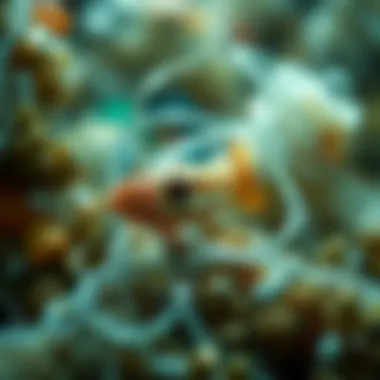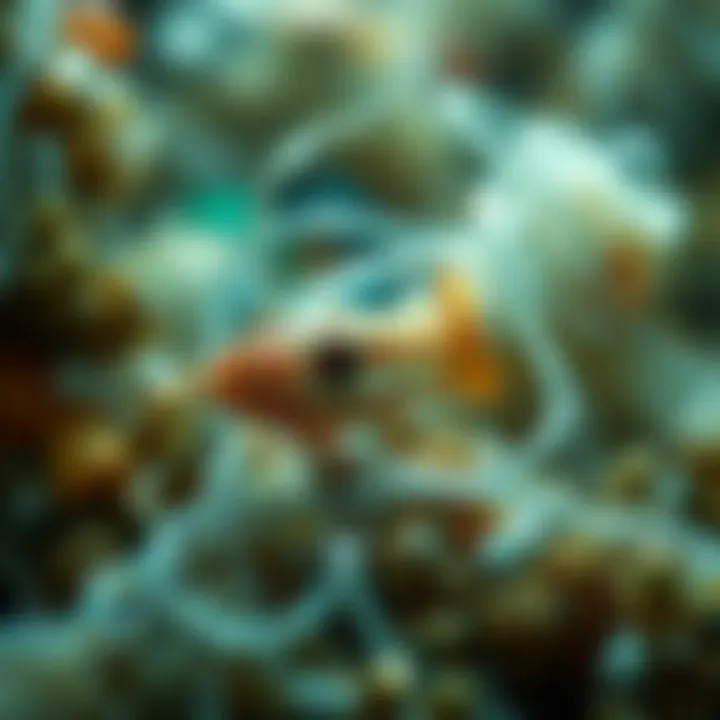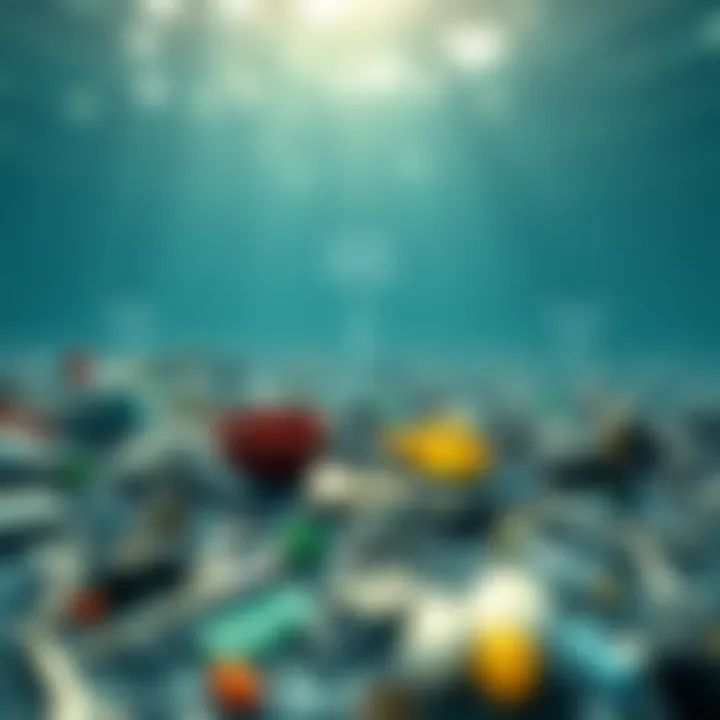The Pacific Trash: Understanding Ocean Pollution


Intro
The Pacific Ocean, often revered for its grandeur and biodiversity, is now facing a dire predicament due to plastic pollution. The journey of plastic debris in this vast blue expanse highlights not just the environmental challenges but also the societal responsibilities we bear. This issue transcends geographical boundaries; it stretches from coastal communities to landlocked nations, implicating all layers of our global society. Understanding the implications of plastic waste in the ocean is crucial for students, researchers, educators, and professionals who strive for sustainable solutions.
The origins of oceanic plastic pollution are as multifaceted as they are alarming. Plastics, created for convenience, last over hundreds of years in the ocean. They can originate from urban runoff, inadequate waste management systems, and even from fishing activities. It is estimated that approximately 8 million metric tons of plastic find their way into the oceans each year, contributing to a crisis of monumental proportions.
Impacts on Marine Life
Impacts of this pollution are severe and wide-ranging. Marine life, from the smallest plankton to the largest whales, often intersects with this toxic debris. Ingesting microplastics, for instance, is causing physiological distress in various species, raising concerns about bioaccumulation—a phenomenon where toxins concentrate in organisms over time. Reproductive challenges and mortality rates are on the rise, threatening entire ecosystems.
Moreover, the Great Pacific Garbage Patch, a massive concentration of plastic debris that spans 1.6 million square kilometers, is a stark example of our negligence. It serves as a grim reminder of the long-term consequences of our actions, effectively altering marine habitats and threatening biodiversity.
"Plastic pollution in the Pacific Ocean is not just an environmental issue; it’s a crisis that intertwines with human health, economic stability, and social responsibility."
As we explore this intricate problem, it becomes vital to consider potential solutions. Addressing the origins of this pollution and implementing strategic waste management practices could alleviate the situation. Engaging communities through education and innovative practices—like beach clean-ups and the promotion of biodegradable alternatives—may lead to cleaner oceans and healthier marine life.
The subsequent sections will delve further into key research findings surrounding this contamination, various methodologies to tackle these issues, and an array of suggested solutions, collectively aiming to equip our readers with comprehensive insights into this pressing environmental challenge.
Prologue to Ocean Pollution
Ocean pollution is a pressing issue that affects not just marine environments but also human health and economic stability. The vastness of our oceans, often thought of as a bottomless pit where waste can disappear, belies the stark reality of their degradation. In this article, we aim to illuminate the myriad aspects of ocean pollution, specifically focusing on the accumulation of plastic waste in the Pacific Ocean. Understanding the seriousness of this topic is essential because it unearths the connections between our daily activities and the health of the global ecosystem.
Defining Ocean Pollution
At its core, ocean pollution refers to the contamination of the oceans by harmful substances, which disrupt the delicate balance of marine ecosystems. These pollutants can take many forms, including chemicals, physical debris, and biological waste. Specifically, plastic pollution has emerged as a significant concern due to its persistence and the sheer volume produced worldwide. Just picture this: every minute, the equivalent of a garbage truck full of plastic ends up in the ocean. That’s staggering!
The significant sources include municipal waste, agricultural runoff, and industrial discharges. When we throw away items like plastic bags, bottles, and straws, many find their way into waterways and, ultimately, the ocean. This mess not only harms fish, birds, and marine mammals but can also travel up the food chain, creating repercussions for human health as well.
Historical Context of Marine Debris
Historically, the notion of ocean pollution was largely invisible. For centuries, coastal communities relied on the ocean for sustenance, but they often overlooked the consequences of their waste disposal practices. In the 1950s, the expansion of plastic usage marked the beginning of a troubling trend. Plastic was the miracle material: lightweight, durable, and cheap. It took hold in households, industries, and commercial sectors before society fully grasped its environmental implications.
The first documented instances of marine debris emerged in scientific literature during the 1960s. Researchers began to find plastic objects among coastal debris. Fast forward to today, and we’ve seen an exponential rise in plastic production, with over 300 million tons produced annually. Many of these materials never fully degrade. Instead, they break down into microplastics, creating persistent hazards.
The Great Pacific Garbage Patch, a collection of marine debris situated between Hawaii and California, serves as a stark reminder of our collective failure to manage waste effectively. The existence of such a vast area filled with floating plastic is more than just an eyesore; it symbolizes a crisis that calls for urgent attention. Understanding this historical context offers insight into not only how we arrived at this juncture but also the choices that lie ahead, either clinging to the past habits or adopting new practices that prioritize the health of our planet.
"We do not inherit the earth from our ancestors; we borrow it from our children." This saying underscores the responsibility we have to future generations in tackling ocean pollution and ensuring a clean, healthy ocean for all.
Understanding the Pacific Trash
Ocean pollution is a growing concern that affects not only marine ecosystems but also human health. In this article, we will dive deep into the phenomenon of the Pacific Trash, an issue that has drawn global attention due to its extensive implications. The importance of understanding the Pacific Trash cannot be overstated, as it represents a crucial intersection of environmental science, policy-making, and social responsibility. By comprehending its complexities, we can better tackle the root causes and formulate effective solutions.
Why Should We Care?
The increasing volume of plastic waste accumulating in the Pacific Ocean isn't just an eye sore; it poses severe threats to wildlife, marine habitats, and human health. Each piece of waste tells a story—stories of poor waste management, lack of public awareness, and neglect of regulatory frameworks. When we familiarize ourselves with the intricacies of Pacific Trash, we unlock the potential for innovative clean-up initiatives and sustainable practices that can reshape our interaction with this vital ecosystem.
Key Aspects to Consider:
- The vast scale and dynamics of the Great Pacific Garbage Patch contribute significantly to the pollution issue.
- Understanding the types of waste prevalent in the Pacific can help identify targeted intervention pathways.
- Societal behaviors and consumption trends play a pivotal role in exacerbating or mitigating this crisis.
By addressing these elements, we can engage in meaningful dialogues about policy changes and community-based actions, ensuring we embrace a comprehensive approach to this environmental challenge. This exploration is not just academic; it’s necessary for mobilizing collective action toward a cleaner ocean.
"The ocean is a reflection of our society, mirroring the waste we produce and the actions we take—or don't take."
Formation of the Great Pacific Garbage Patch
The formation of the Great Pacific Garbage Patch is a glaring example of how human activity leads to environmental degradation. Situated between Hawaii and California, this area is notorious for its high concentration of marine debris, mainly plastic. But how did this colossal patch come to be?


In essence, the patch is primarily a product of ocean currents and human negligence. The North Pacific Gyre, a system of rotating ocean currents, captures debris and holds it in this region. Over the years, materials discarded on land—carried by rivers and stormwater—flow into the ocean and get swept up in these currents. Consequently, plastic and other types of waste accumulate, becoming trapped and forming a swirling mass of pollution that harmfully affects marine life.
Factors contributing to this formation include:
- Waste mismanagement on land, resulting in higher volumes of plastic reaching waterways.
- Consumer culture, which drives the excessive use of single-use plastics without a thought towards responsible disposal.
- Fragmentation of larger debris, which breaks down into microplastics, making it nearly impossible to remove once in the ocean.
Types of Waste Found in the Pacific
Understanding the specific types of waste in the Pacific is crucial for effective remediation. The majority of the debris consists of various forms of plastic, broken down into different categories:
- Microplastics: Tiny plastic particles less than five millimeters in diameter that often come from larger plastics breaking down.
- Fishing gear: Abandoned, lost, or discarded nets, lines, and traps, which continue to entangle marine species long after they’ve left the hands of their owners.
- Beverage containers: These bottles make up a significant portion of visible debris and are often left behind or improperly discarded on coasts.
- Styrofoam and polystyrene products: Lightweight and buoyant, these materials are particularly problematic as they easily break apart in water, contributing to the microplastics issue.
By identifying and categorizing these waste types, we can work to develop targeted strategies for their removal and educate communities about how to reduce their contribution to this global crisis. The more informed we become about the waste lurking beneath the ocean’s surface, the more empowered we are to initiate change.
Sources of Marine Pollution
Understanding the sources of marine pollution is key to tackling the challenge of oceanic debris, especially in the Pacific. Pollution doesn’t appear out of thin air; it travels from places where human activity thrives. These sources can be split into two major categories: land-based contributions and ocean-based contributions. Recognizing the origins of marine pollution not only brings awareness to the problem but also helps outline actionable steps to mitigate its impacts.
Land-Based Contributions
Land-based sources of marine pollution account for a staggering portion of the waste found in our oceans. Everyday life often leaves a mark that doesn’t stay on land—plastic wrappers, discarded fishing gear, and untreated sewage all find their way to waterways. When it rains, trash that graces our streets flows into rivers, eventually reaching the ocean. This scenario plays out globally, affecting water quality and the ecosystems dwelling within.
Some of the prominent land-based contributors include:
- Industrial Waste: Factories that dump untreated byproducts into nearby streams can introduce heavy metals and toxins into the marine environment.
- Urban Runoff: Cities create impervious surfaces, causing rain to wash garbage straight into drainage systems without filters.
- Agricultural Practices: Runoff from farms brings fertilizers, pesticides, and herbicides into the oceans, disrupting the natural marine ecosystem.
The cumulative effect of these land-based pollutants leads to widespread contamination. Numerous studies indicate that plastics—especially microplastics—pose a severe risk to marine life, as they’re often consumed by fish and other animals. This is not just a matter of aesthetic concern; it has severe implications for biodiversity.
Ocean-Based Contributions
Ocean-based contributions of pollution are equally significant but often overshadowed by the noise around land pollution. Commercial activities like shipping and fishing have direct implications for ocean health. Shipwrecks and oil spills not only pollute but also disrupt ocean habitats. Let’s take a closer look at some common ocean-based sources of pollution:
- Shipping Activities: Each vessel that traverses the Pacific Ocean can unwittingly release toxic substances, specifically oil, bilge water, and garbage.
- Fishing Operations: Lost or abandoned fishing gear, often dubbed "ghost gear," continues to catch fish and other marine species, leading to unintended deaths.
- Marine Tourism: While important to many economies, high traffic from boats and leisure activities can lead to localized pollution, including physical debris and chemical runoff from recreational vessels.
The impact of these ocean-based sources manifests in various ways. Marine ecosystems can be destabilized, and native species can face dwindling numbers. Furthermore, pollution travels beyond its point of origin, creating larger issues in distant waters, where it disrupts the balance of marine food webs.
"The health of oceans affects all of us, as they play a vital role in regulating climate and supporting life on Earth."
In summary, addressing pollution in the Pacific is not just about cleaning up what we see but understanding where it comes from. Identifying the major sources can concentrate efforts where they are most needed. By highlighting these contributions, it is possible to encourage policies and community actions that protect our oceans from ongoing pollution.
Impacts on Marine Ecosystems
The Pacific Ocean, teeming with life, faces a dire threat from pollution, especially plastic waste. This section delves into the impacts on marine ecosystems, showcasing how pollution doesn't just affect the ocean; it reverberates through the interconnected web of life that depends on it. The significance of understanding these impacts cannot be overstated. The health of oceans directly influences weather patterns, global economy, and the interplay of life on Earth. Recognizing this helps create a more comprehensive view of the crisis.
Effects on Marine Life
Impact on Biodiversity
When we talk about biodiversity, we’re referring to the variety of life forms existing within a specific ecosystem. Pollution creates profound disturbances in these ecosystems, often leading to a decline in the number and variation of species. This is especially harmful in the Pacific, where complex habitats like coral reefs and kelp forests are found. Studies have indicated that certain pollutant types, particularly microplastics and chemicals, can drastically decrease reproductive rates and survival chances of many marine species.
The key aspect of biodiversity’s impact is its role in ecosystem stability. A rich variety of organisms ensures resilience against environmental changes. When pollution reduces this variety, ecosystems become vulnerable, which can lead to a collapse of local fisheries or loss of important species, affecting everything from the smallest plankton to the largest whales.
This article shines a light on how essential it is to recognize these dynamics—understanding how pollution disrupts biodiversity gives insight into broader ecological functions and makes a compelling case for conservation efforts. The unique feature here is how pollution not only harms visible marine life but also diminishes the unseen organisms that underpin the entire marine food web. The disadvantages of neglecting biodiversity's resilience can be catastrophic, crafting a domino effect that spirals through marine ecosystems.
Trophic Level Disruption
The concept of trophic levels refers to the hierarchical levels in an ecosystem where organisms are classified based on their feeding position. From producers, like phytoplankton, to apex predators, every level plays a significant role. Pollution, particularly plastic and toxins, disrupts these levels by introducing substances that can alter food availability and introduce harmful chemicals into the biological chain. For instance, when smaller fish ingest plastic, larger predators who consume them, like sharks or dolphins, end up accumulating high levels of toxins, which can lead to population declines.


A key characteristic of trophic level disruption is the cascading effect it has—disruption at one level can lead to shortages at another. This makes addressing trophic disruption pivotal for restoring ocean health. One unique feature of this disruption is how it tends to get overlooked in discussions about marine life—it's easy to see the damage to big marine animals but harder to appreciate the damage done deeper in the food web. The advantages of studying these disruptions are immense; they highlight the ripple effects of pollution and the urgent need for innovative solutions to mitigate these impacts.
Coral Reef Degradation
Coral reefs, often called the "rainforests of the sea," are among the most biodiverse ecosystems on the planet. However, the rise of pollution, particularly in the form of plastic waste and nutrient runoffs, leads to coral bleaching—a process where stress from toxins deprives corals of their vibrant colors and the symbiotic algae they rely on for nutrients. The slow death of coral reefs not only affects marine creatures that rely on them for habitat but also impacts coastal communities that depend on thriving reefs for tourism and fishing.
Coral reefs contribute substantially to marine biodiversity, and their degradation threatens various marine species, many of which have yet to be studied or even discovered. Protecting these delicate ecosystems demands urgent action to reduce pollution and implement conservation strategies. Recognizing the depth of coral degradation provides insight into broader environmental impacts and the dire need for protective legislation and community action.
Influence on Human Health
The impact of oceanic pollution on human health is a pressing issue that extends beyond environmental degradation and touches the very essence of human well-being. Understanding how pollutants, particularly those found in the Pacific Ocean, affect human life is crucial for raising awareness and promoting change. Within this context, it’s important to dive into two specific areas: the bioaccumulation of toxins and the potential risks posed to seafood consumers. These aspects are vital for comprehending the broader implications of marine pollution on public health.
Bioaccumulation of Toxins
Bioaccumulation refers to how certain substances, including heavy metals and plastic-derived chemicals, can accumulate in the tissues of living organisms over time. In oceans like the Pacific, pollutants enter the food chain, beginning with microscopic organisms such as plankton and moving their way up to larger marine species. This process occurs because many of these pollutants are resistant to degradation, persisting in the ecosystem and becoming more concentrated as they ascend the food web.
- Mechanism of Toxic Accumulation: Plastics break down into microplastics, which can be ingested by small fish and cephalopods. Once inside, these toxins can enter the bloodstream of these organisms, creating a toxic landscape for higher predators, including humans.
- Common Toxins: Cadmium, lead, and mercury are among the toxic elements that bioaccumulate and can cause grave health issues, such as neurological disorders and developmental problems.
A study from Stanford University highlights that species like swordfish and tuna often have alarmingly higher levels of mercury due to consuming smaller, contaminated fish. These findings lead to serious health concerns for populations that rely heavily on seafood for their dietary protein.
"As these toxins travel up the food chain, the risk to human health escalates increasingly, making awareness and understanding a matter of urgency."
Potential Risks to Seafood Consumers
The consumption of contaminated seafood presents tangible risks to human health, particularly among communities with high seafood consumption rates. Understanding these risks necessitates a closer examination of the following factors:
- Health Issues Associated with Consumption: Persistent organic pollutants (POPs) and heavy metals can trigger serious health repercussions. Conditions ranging from reproductive problems to immune dysfunction are linked to the ingestion of these toxins, potentially leading to chronic diseases.
- Vulnerable Populations: Fishermen and coastal communities are at a higher risk, often unaware of the levels of toxins within the fish they catch and eat. Pregnant women, infants, and children are especially vulnerable to the effects of mercury and other toxins, leading to greater emphasis on monitoring and regulations.
- Economic Implications: The viability of local economies is also at stake. Should seafood consumption become dangerous, local fisheries may face significant downturns as the demand for contaminated products shrinks.
In summary, the influence of oceanic pollution on human health encapsulates complex interactions marked by bioaccumulation of toxins and potential risks faced by seafood consumers. Understanding these elements becomes essential not only for the preservation of health but also for promoting sustainable practices. Through this awareness, communities and individuals can champion efforts to mitigate these pressing issues, paving the way for a healthier relationship with our oceans.
Current Research and Findings
The significance of current research and findings in understanding ocean pollution, particularly focused on the Pacific, cannot be overstated. Advances in marine science have surfaced new methodologies in tackling pollution, helping us to uncover the extent and implications of waste in our oceans. By evaluating studies on pollution and exploring innovative solutions, we gain insight into both the gravity of the issue and viable paths to recovery. So why does this matter? Well, the Pacific Ocean is a crucial part of our planet's ecosystem. Each ounce of research can shape policy decisions, influence conservation efforts, and guide community initiatives aimed towards combating pollution.
Studies on the Scope of Pollution
Research on the scope of ocean pollution is critical. Scientists and environmentalists have dedicated time to investigating the vast quantities of plastic and other debris that end up in ocean waters. One significant area of study is the measurement of microplastic concentrations. These tiny fragments, which are often less than five millimeters in size, pose serious threats not only to marine life but also to humans indirectly through the food chain.
Recent studies, like those published in Environmental Research Letters, have shown that microplastics are present in varying quantities across the Pacific. They have been found in the deepest trenches and at the surface, suggesting that pollution is indeed pervasive and affects not just surface-level life but entire ecosystems. It's noteworthy that the more sloshed about ocean currents disperse these particles over vast areas, leading to unexpected concentrations in specific hygienic zones, such as gyres.
"The Great Pacific Garbage Patch is more than just a patch; it is a representation of our consumption. Each piece tells a story of human negligence and the ocean's resilience."
To shed lights on specifics, the Ocean Cleanup project, an initiative aimed at reducing debris from the oceans, has released its findings documenting substantial quantities of both macro and microplastics across various Pacific regions. This data reveals not only the statistical scope of the pollution but also aids in prioritizing areas for cleanup and further research.
Innovative Solutions Explored
The quest for innovative solutions to ocean pollution unveils a realm of possibilities fueled by creativity and science. Various organizations and researchers are looking at multi-pronged approaches that span from technology development to policy-making.
- Biodegradable Materials: Many innovators are focusing on developing biodegradable alternatives to conventional plastics. For example, companies like Avani Eco are producing biodegradable bags from cassava starch that break down easily without leaving harmful residues behind.
- Floating Barriers: Technologies such as floating barriers are being tested to catch debris in major currents before it fragments into microplastics. The Ocean Cleanup project has been particularly notable in deploying this technology in the Great Pacific Garbage Patch.
- Recycling Innovations: Creatively rethinking recycling processes is another area seeing significant research. Efforts are underway to develop methods that can better recover materials from disposed plastics, transforming them into reusable resources. Recent studies have explored advanced sorting technologies that can increase the efficiency of recycling plants.
- Community Engagement Programs: Social solutions are equally important. Research into community-based programs aims to raise awareness about plastic use and pollution. Educational initiatives, often spearheaded by local non-profits, engage schools and communities in cleanup efforts, fostering stewardship of marine environments.
In summary, the research on both the scope of pollution and the innovative solutions to tackle it paints a complex yet hopeful picture. There is a shared responsibility, one that spans nations, organizations, and individuals. Tracking these developments not only informs policies but also cultivates direct community involvement in the movement towards cleaner oceans.
Mitigation Strategies
The ongoing crisis of pollution in the Pacific Ocean calls for immediate action and innovative approaches. Mitigation strategies serve as a beacon of hope, offering pathways to not only address the crisis but also to prevent future degradation of marine environments. The emphasis on these strategies is crucial, as they involve multifaceted efforts that can be implemented across various levels—government policy, community initiative, and individual responsibility. Solutions need to be tailor-fit to local conditions while encompassing broader systemic changes.


Policy Initiatives and Legislation
Effective legislation is necessary to combat ocean pollution, particularly when it comes to regulating waste management and reducing plastic production. Policies at both local and international levels must align to maximize impact. Some significant legislative efforts include:
- Bottle Deposit Laws: These incentivize recycling by offering monetary returns on bottle returns, which can substantially reduce litter.
- Single-Use Plastic Bans: Many regions have begun to phase out plastic bags and straws, promoting reusable alternatives instead.
- Extended Producer Responsibility (EPR) Policies: This mandates manufacturers to take responsibility for the lifecycle of their products, including disposal and recycling, helping to mitigate waste at the source.
"Legislation is the backbone of effective pollution management. Without it, efforts can falter and fail to create the needed changes in behavior and practice."
Furthermore, international treaties, such as the Montreal Protocol, while originally aimed at protecting the ozone layer, have set a precedent for global cooperation on environmental issues. As countries commit to reducing their environmental footprints, they can collectively tackle pollution more effectively.
Community-Based Cleanup Efforts
While policy-driven initiatives form the foundation for larger-scale change, grassroots efforts prove equally vital. Community-based cleanup programs empower residents to take charge of their local environments. Examples of such initiatives include:
- Beach Cleanups: Often organized by local non-profits or community groups, these events not only clean the shorelines but also raise awareness about pollution.
- Adopt-a-River Programs: Communities can take proactive stances by adopting and regularly cleaning portions of rivers that lead into the ocean, thus preventing debris from entering marine ecosystems.
- Educational Workshops: Offering sessions on waste management and recycling helps instill a culture of responsibility.
The collective impact of community efforts can shift social norms, making cleanliness and sustainability part of daily life. Connecting individuals to their environmental footprint fosters a sense of stewardship and responsibility, which is crucial for long-term change.
In sum, incorporating robust policy initiatives alongside active community strategies forms a comprehensive approach to mitigate ocean pollution. Each element enhances the other, creating a powerful synergy in the fight against the Pacific Trash crisis. It is through these combined efforts that real, lasting change can be achieved.
Future Outlook
The future outlook regarding ocean pollution, particularly in the Pacific, is not merely a scientific concern but a poignant social issue. It encapsulates the interplay between human activity and the health of our oceans, drawing a direct link between individual choices and global consequences. In this section, we delve into the anticipated trends and necessary projections that could shape our collective future with regards to marine debris.
Predicting Trends in Ocean Pollution
When one thinks of ocean pollution, it’s easy to get lost in despair over the current state of affairs. However, understanding the predictive trends is crucial for charting a course toward corrections. Based on recent research, experts have identified a few emerging patterns:
- Increased Plastic Production: The global production of plastic continues to rise, with estimates suggesting an increase from 368 million tons in 2019 to over 1.6 billion tons by 2030. As more plastic is produced, it will inevitably find its way into the ocean if no mitigating measures are taken.
- Shifts in Marine Wildlife Migration: With changing ocean temperatures and pollution hotspots, marine species are likely to alter their natural migratory patterns. This could affect local fishing communities and disrupt ecosystems that are already under threat from pollution.
- Multi-Sectoral Involvement: There's a growing recognition among industries and governments that tackling ocean pollution requires a multi-sectoral approach. Collaborations among environmentalists, policymakers, and private sectors seem to become more prevalent as stakeholders recognize the long-term benefits of a clean ocean.
- Technological Advancements: Innovations in waste management and ocean clean-up technology are expected to progress rapidly. From drones to advanced filtration systems, these tools hold promise for more efficient debris removal and pollution tracking.
Long-Term Recovery Projections
As we peer into the future, it’s also crucial to analyze long-term recovery projections for our oceans. A few key elements define these projections:
- Timeframe for Ecological Recovery: Scientific models suggest that if pollution trends are successfully curbed, certain ecosystems may show signs of recovery within decades. For instance, some marine life is quite resilient, and habitats like mangroves and seagrass can restore biodiversity over time if protected.
- Economic Considerations: Clean oceans not only benefit wildlife but also present economic opportunities through sustainable fishing and tourism. Studies have indicated that for every dollar spent on ocean health initiatives, the economic returns could be tenfold when factoring in enhanced tourism and fisheries.
- Policy Implications: Government legislation could play an imperative role in facilitating this recovery. Recommended policies could involve stricter regulations on plastic production and a boost in funding for cleanup efforts.
Effective policy frameworks, responsive to scientific findings, will be key to mitigating marine pollution and ensuring a sustainable future.
In summary, as we contemplate the future of ocean pollution, we see both challenges and possibilities. A predictive view allows us to tailor proactive solutions rather than reactive measures. The path ahead is often dictated by the actions we take today—how policies are formed, innovations are nurtured, and global discourse evolves. This will ultimately determine the health of our Pacific and, by extension, the planet we all share.
Epilogue
Summarizing the significant issues surrounding ocean pollution, especially in the Pacific, is vital for creating awareness and inspiring action. The pressing reality of marine waste accumulation, primarily driven by plastic, underscores the interconnection between human activity and environmental health. This article has explored various facets of ocean pollution; from understanding its origins to examining its repercussions on both marine ecosystems and human health. It becomes clear that the implications of neglecting our oceans can be dire—not just for wildlife but also for our own future.
Summarizing Key Insights
Throughout our examination, several key insights emerge:
- The Proliferation of Plastic Waste: The sheer volume of plastic found in the ocean, particularly within the Great Pacific Garbage Patch, highlights a broader failure of waste management systems worldwide. This not only impacts marine life but also exacerbates climatic issues.
- Health Risks: The ongoing bioaccumulation of harmful substances poses significant risks to human health, especially for communities reliant on seafood. What is seen as disposable today can have lasting effects, echoing in future generations.
- Advancements in Research: Innovative solutions are being explored, from biodegradable materials to advanced cleaning technologies. We are beginning to see that it is not just about addressing existing waste but preventing future accumulation as well.
- Collective Responsibility: The findings underline the need for collaboration between governments, organizations, and individuals. Policy changes and grassroots initiatives can create a robust framework for combating this issue.
Ultimately, it is about connecting the dots between our actions and their impacts on the environment. Only through understanding the depth of these challenges can meaningful solutions be crafted.
Call to Action
As stewards of this planet, we must collectively rise to the occasion. Here are some actionable steps everyone can take:
- Educate and Advocate: Spread awareness among peers about the issues associated with ocean pollution. Knowledge is power; the more people understand, the more change can happen.
- Participate in Cleanups: Engage in local cleanup efforts, whether they're organized beach cleanups or community litter collection initiatives. Every little bit helps in reducing waste in the ocean.
- Reduce Plastic Use: Make conscious decisions to minimize reliance on single-use plastics. Consider alternatives like reusable bags and containers, and support businesses that prioritize sustainability.
- Support Legislation: Advocate for stricter policies on waste management and plastic usage at local and national levels. Laws and regulations can have profound impacts on reducing pollution.
- Stay Informed: Follow ongoing research and advancements in ocean conservation. Being aware of new findings and recommendations can help you adapt your behavior to suit our evolving understanding of environmental issues.
Taking these steps, while seemingly small, can contribute to a larger tide of change against ocean pollution. Together, we hold the potential to safeguard our oceans for generations to come.
"The ocean is a common heritage, and its health reflects our collective respect for life on Earth."
For more on marine conservation efforts, visit organizations like Ocean Conservancy and explore research through National Oceanic and Atmospheric Administration for further insights.



